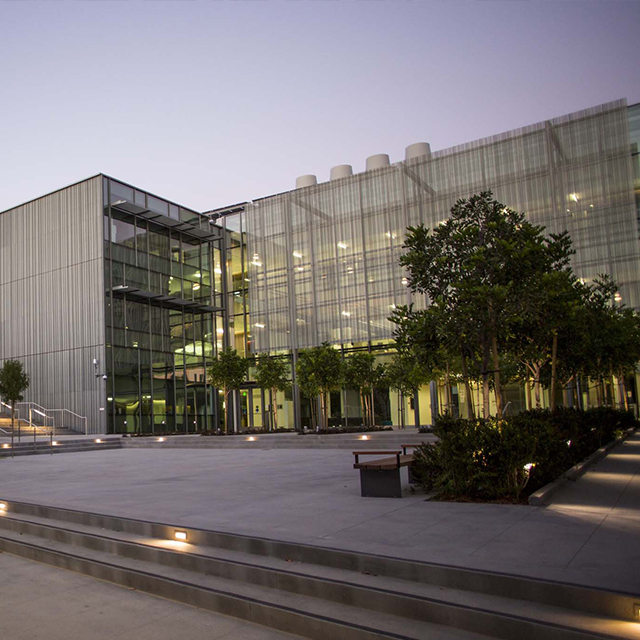LOS ANGELES – C.W. Driver, a premier builder serving the Western U.S. since 1919, recently completed construction on the $110 million, 100,000-square-foot Life Sciences building at Loyola Marymount University (LMU) in Los Angeles. Construction on the project began in June 2013 and completed in August 2015.
The new Life Sciences building, designed by CO Architects, houses faculty and research staff from the disciplines of Biology, Chemistry and Biochemistry, Health and Human Sciences, Civil Engineering, and Environmental Science under the Seaver College of Science and Engineering. It equips faculty and students with modernized laboratories and collaborative research space to provide an optimal learning environment for science and engineering.
“LMU’s goal for the new Life Sciences building was to provide a cutting-edge space that would allow the faculty and students to tap into the latest technology and grow as scientists,” said Matthew Wilt, project manager at C.W. Driver in Los Angeles. “As a result, the construction process also entailed a variety of technologies and innovative processes to deliver the new standard in science classroom spaces.”
Given the building’s complexity, C.W. Driver, partnering with CO Architects, conducted an extensive quality assurance/quality control review prior to construction to proactively resolve any conflicts within the extensive mechanical, electrical, plumbing and fire control system pathways. Technology played a major role in resolving any conflicts presented. The project team utilized REVit, BIM360 and Box.com to efficiently develop and push building plans through all necessary approvals, which allowed C.W. Driver to proactively order materials with long lead times, and even coordinate the prefabrication of systems like the plumbing racks offsite, to further increase productivity and remain on schedule.
In order to fully utilize the existing site footprint, C.W. Driver constructed the three-story facility with three levels of underground parking. Floor to ceiling glass storefront was used at the corridors throughout the building, allowing students to observe what their peers are working on in the lab space and further enforcing the collaborative nature of the environment. This collaborative concept is featured throughout the building’s 35 teaching labs, 40 faculty and staff offices, 9 informal student study spaces, a green roof and outdoor laboratory, three conference rooms and a 273 fixed seat auditorium, in addition to six accessible spaces, with an adjoined 1,800-square-foot terrace.
The auditorium is a separate structure, with a cutting edge point supported structural glass system that covers the front and sides of the space and is connected to the main building by the overhead green roof terrace. The green roof is accessible by way of a 200-foot ramp with stairs built from the building’s courtyard level that leads visitors all the way up to the roof over the auditorium.
The university’s commitment to reduce its carbon footprint was an additional goal for the project. The building is targeted to achieve LEED® Gold certification, well exceeding its previous LEED® certification goal of LEED® Silver. Many technologies have been put in place to help reach that goal, including a solar screen on the west façade to reduce radiant heat and a cutting edge “chilled beam” air conditioning system in all labs and faculty offices.
Adding to the collaborative nature of the project, C.W. Driver’s project team worked closely with the university and the architect throughout the construction process. C.W. Driver helped to mitigate loud noise and fume emissions during the project to ensure classes and other events on campus were not disturbed. A 12-foot wood sound wall was set around the construction site along with various containment rooms made for cutting steel and other construction materials to help mitigate the loud noise propagation. C.W. Driver also opted to use an electronic powered tower crane to assist with construction, which cut down additional noise and fumes.
Even after the project’s completion, C.W. Driver will continue to provide LMU with further facility assistance. An iPad will be given to the LMU Facilities Management team containing all final documents and information to operate all utilities throughout the facility. A C.W. Driver specialist will stay after the project’s completion to work alongside facility maintenance groups, training the staff on all mechanical functions in the building. Each training session will be filmed with the video of each made available on the iPad, allowing original training footage to be accessible to current and future staff.
“We couldn’t be more pleased to open the doors of this building to our students,” said Tina S.W. Choe, dean of the Frank R. Seaver College of Science and Engineering at LMU. “What’s so exciting is that with our new facilities, LMU will be at the forefront of educating the next generation of scientists for decades to come.”
In addition to Wilt, the C.W. Driver project management team members include Mike Byrne, senior vice president; Brian Rush, project executive; Chris Butler, general superintendent; Jon Wilson, superintendent; Dan Martinez, superintendent; Jared Brown, assistant superintendent; Ryan Takasugi, senior project engineer; Britney Calucag, project engineer; Mark Hunter, BIM manager; and Greg Koselke, project planner.
The Life Sciences building is one of a number of projects in which C.W. Driver has been involved within the biomedical/life sciences field in California, including the Sciences Building at Saddleback College in Mission Viejo, Steven Spielberg Building and Microbiology Lab at Cedars Sinai Medical Center in Los Angeles; the Health and Sciences Complex at Grossmont College in El Cajon; and six other completed projects, which include biology, physics and laser labs in various buildings throughout the Caltech campus in Pasadena.


